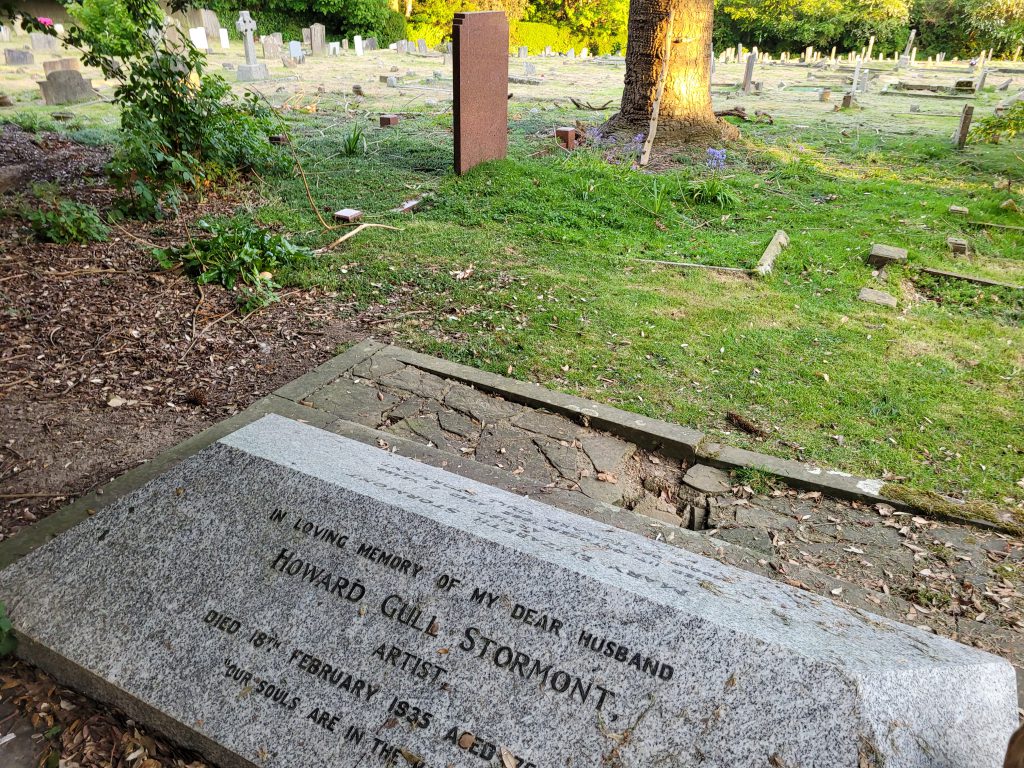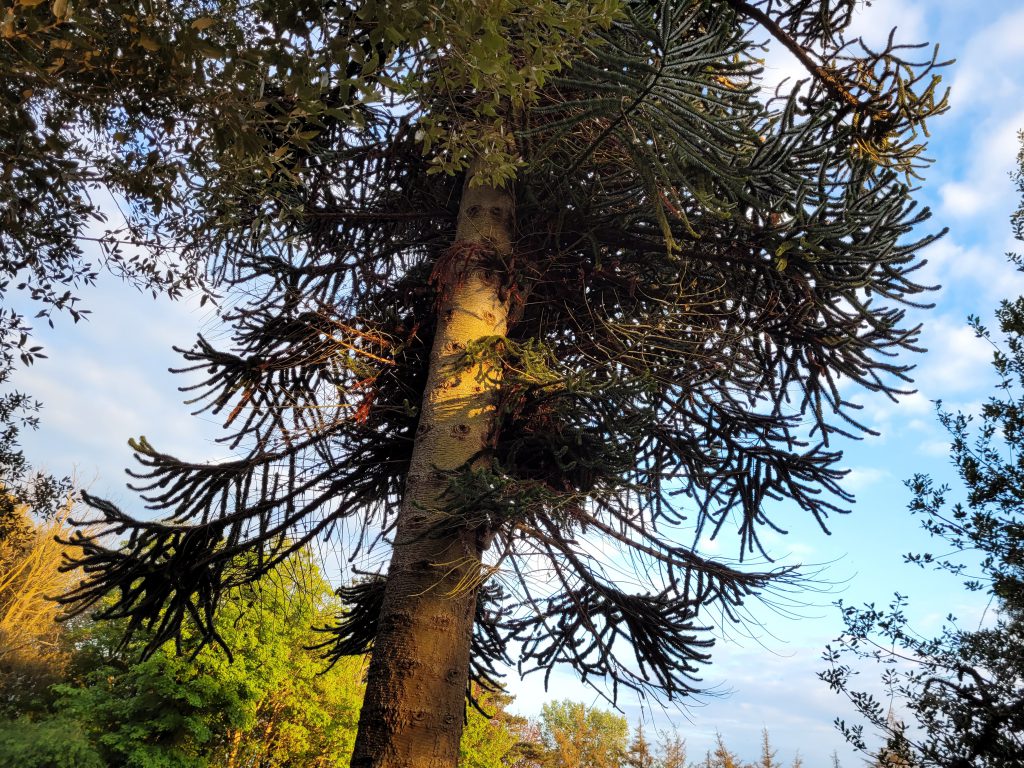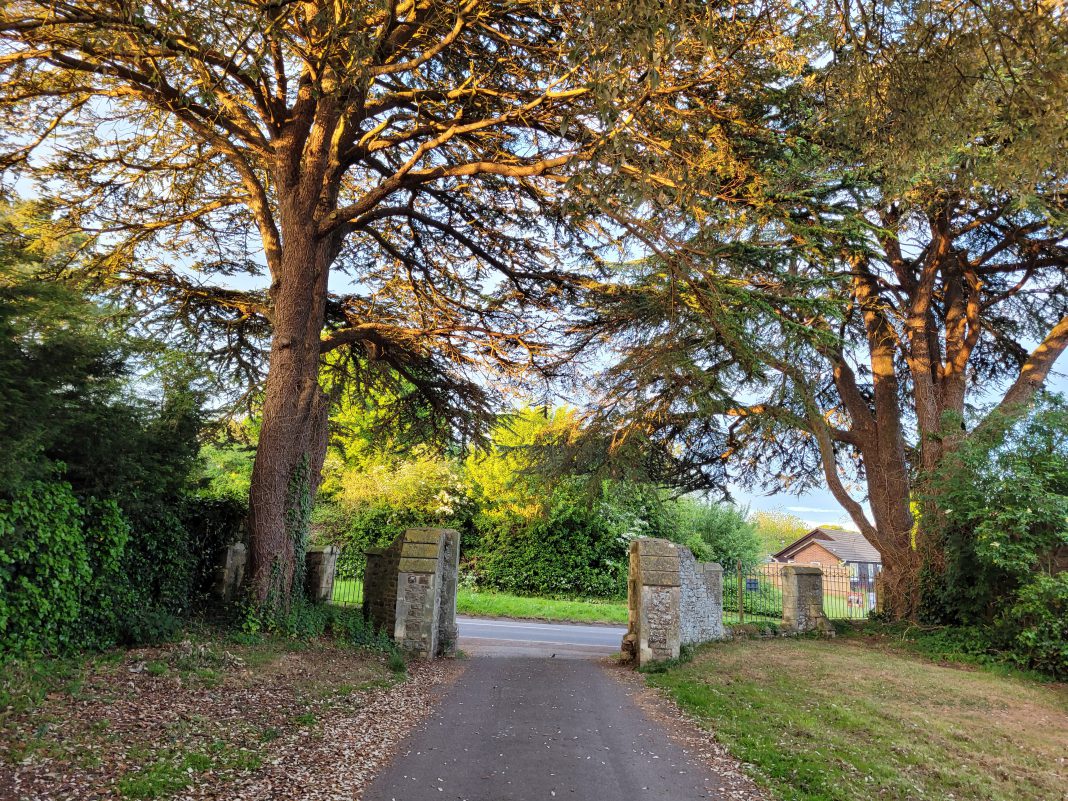Walking past Rye Cemetery, one does not imagine there is an entire world beyond those towering pines that guard the gateless gateposts. The ancient trees hold clues to the history of this place. If only they could speak.

Daisies and nodding fluff-filled dandelions have now replaced the daffodils and snowdrops, which had filled the crevices around the fallen and standing stones at Rye Cemetery. So many names gone with the rubbed off rubble and crumbling headstones. Those that remain, readable and proclaiming their presence are Mary Stormont with her artist husband, Howard as well as EF Benson the author of the Mapp and Lucia books, two-time Mayor of Rye and son of an Archbishop of Canterbury (with a hefty tombstone in traditional style).

Dog walkers and those seeking quietude are among those who cut across this extraordinary piece of land to walk down from Rye Hill to Love Lane, taking in the Tilling valley. It is beautiful, like paintings etched under clouds by sunlight.
There is a Pauper’s chapel, not in use anymore, which stands proud braving the elements. Opposite this chapel is a ruin, across another wide girthed pine tree that looks like it has witnessed all the comings and goings in Rye. The Highborn chapel nearly burned to the ground and was lost to history therefore.
Recently I have felt concern as red and yellow bollards have popped up, as if propping up a fence around the Paupers’ Chapel, like so many unwanted gravestones. I shuddered. Is the building now condemned? The other day I stopped to ask one of the Maintenance team. David said that he had walked into the gothic-style chapel the previous month and nearly been bludgeoned by a falling brick. These are not our modern red bricks, but heavy stones the size of a Britannica Encyclopaedia! The building is therefore awaiting an assessment. The brickwork directly above the lintel area of the main door has severe structural damage to it. “Is it condemned then?” I asked. David said the official review is outstanding, while his colleague reminded us, “It is a listed building after all!”

So, as I dig up the past, taking the short cut, which leads us dog walkers past pretty views down to Love Lane, this jaunt through the silent pathways that have been tread by the great and the good, and all those wishing to pay their respects to the dead, I’m reminded that they are never forgotten.
The Maintenance team from Rother District Council have just trimmed the overgrowth among the stones, and the remainder will be tended this week. The Rye Union Workhouse stood here, there is a plaque declaring its poignant past. The children’s burial area is overgrown with the colours from both satin imitation florals, and real potted hyacinths and pretty hedgerows.

Our movements are so often motivated. I lost our first child. A daughter, today she would have been sixteen. Her remains rest in the Garden of Remembrance at Golder’s Green. I can’t visit as often as I’d like. I saw a woman in her seventies alight from a car right beside EF Benson’s historic graveside. She was attending a much smaller site, laying stones on meshing to avoid unwanted weeds springing through. She said how she can’t come as often as she likes as she has moved away from Rye Hill. I found myself telling her about my child and promising to oversee the resting place of her mother and child brother, lost in the last world war.
This is a place that has stood witness to so much. The gravel crunches with the sound of untrodden steps I feel, as I watch my Labrador strain against his lead looking longingly at the squirrel scooting up the monkey puzzle tree. From his drone-level view the squirrel looks out across this spread of people past and I wonder about the future of these historic bricks.

Image Credits: Anwesha Arya .




What a delightfully written article, a pleasure to read. I looking forward to visiting the cemetery as a passer-by.
Re the resting place of Howard and Mary Stormont, the original Friends of Rye Art Gallery arranged for the memorial to be cleaned and the lettering restored in about 2014. Very pleased to see that it is appreciated.
I’m sorry I missed this article first time, but last week my mind was elsewhere, attending two friends’ funerals.
As the retired architect who organised the plaque for Rye Foreign Parish Council, I feel I should correct several errors in the article:-
1. The Gateposts were the base of the two storied meeting room/ gatehouse for the Rye Union Workhouse
2. The remaining Chapel wasn’t for Paupers, it was for the Church of England, now deconsecrated.
3. The western Chapel was for Non Conformists and all non Anglicans.
4. It wasn’t burnt to the ground. A fire was started against a wall and burnt the roof, but the walls were stable. The Council demolished it, all but a few scraps of masonry./Users/chrismcgrath/Desktop/Rye Cemetery Chapel.png
5. No-one could be bludgeoned to death by a brick, as the material is stone. A quick inspection didn’t reveal any missing stones, but I may have missed one.
6. There is no lintel over the west door, it is a gothic arch and the filled fracture above is historic.
7. The Chapel is, sadly, not Listed.
8. The Union Workhouse is still there; converted to my plans into 16 houses and flats, unfortunately emptied of tenants and sold by the Housing Association.
9. The plaque commemorates several hundred inmates who are buried in unmarked graves.
I apologise if these corrections seem intemperate, but I am very fond of the Cemetery and wanted to put the record straight.
Thanks for these corrections Chris, I was just preparing a similar list of errors. I too am fond of this beautiful cemetery and have walked through it a thousand times; taking in the splendid views, the sadness, beauty and sense of history. ‘Paupers and Highborn’: nonsense. Oh and the ‘wide birthed pine tree’ between the chapels is a Cedar Of Lebanon – it has indeed witnessed many comings and many goings in Rye …
….and of course the cemetery is now recognised as a site of Commonwealth War graves.
https://www.ryenews.org.uk/news/new-status-for-cemetery
If there were a group interested in preserving the Chapel and cemetery, l would like to be included. My ancestors and more recent relations are buried here. The very first harbourmaster Stephen Britt was buried here in 1867 and lm proud to be a descendent. I would love to see within the Chapel and hope never to see it demolished, it’s a spiritual, sacred place to be cared for and cherished.